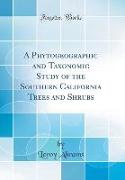- Start
- A Phytogeographic and Taxonomic Study of the Southern California Trees and Shrubs (Classic Reprint)
A Phytogeographic and Taxonomic Study of the Southern California Trees and Shrubs (Classic Reprint)
Angebote / Angebote:
Excerpt from A Phytogeographic and Taxonomic Study of the Southern California Trees and ShrubsThe topography is broken and irregular, with numerous moun tain ranges separated by narrow passes or valleys of greater or less extent. The main axis of these mountains lies generally parallel with the coast at a distance of 40 to 120 kilometers inland. At intervals of 60 to 100 kilometers narrow passes divide this axis into several rather distinct sections. Of these sections the north ernmost, which lies between Tejon and Soledad Passes, is composed of a series of comparatively low, Chaparral-covered mountains, the culminating peak of which (liebre Mountain) is only 1737 meters above the sea. South of Soledad Pass, between it and Cajon Pass, are the rugged peaks of the San Gabriel Mountains, which rise abruptly out of the coastal valleys to altitudes ranging from 1800 to over 3000 meters (mount San Antonio 3024 meters). The San Bernardino Mountains, although less broken and irreg ular, reach even higher altitudes. In this range, which is separated by the narrow Cajon Pass from the San Gabriel Mountains, is the highest mountain south of the Sierra Nevada (san Gorgonio, 3428 meters). Extending southeastward from Mount San Gorgonio, at a much lower altitude, are the desert ranges, the Cottonwood and the Chuckawalla Mountains, which separate the Mohave and the Colorado Deserts. To the southward, again, between the Colorado Desert and the coastal region, rise the San Jacinto Mountains. The eastern base of Mount San Jacinto, the highest peak in this range, rests almost directly upon the low depressions of the Colorado Desert (palm Springs, altitude 137 meters) while its summit, scarcely eight miles distant in an air line, rises with an almost sheer ascent to 3242 meters. South of the San Jacinto Mountains are the less rugged Palomar, Santa Rosa, and Cuia maca Mountains. This series of mountain ranges divides the deserts from the coastal region, and is one of the principal factors which in¿uence the climate of southern California.The arid desert country east of the mountains, comprising over one half the entire area of southern California, is separated by the Cottonwood and Chuckawalla Mountains into two distinct divisions, the Mohave and the Colorado Deserts.About the PublisherForgotten Books publishes hundreds of thousands of rare and classic books. Find more at www.forgottenbooks.comThis book is a reproduction of an important historical work. Forgotten Books uses state-of-the-art technology to digitally reconstruct the work, preserving the original format whilst repairing imperfections present in the aged copy. In rare cases, an imperfection in the original, such as a blemish or missing page, may be replicated in our edition. We do, however, repair the vast majority of imperfections successfully, any imperfections that remain are intentionally left to preserve the state of such historical works.
Folgt in ca. 10 Arbeitstagen
